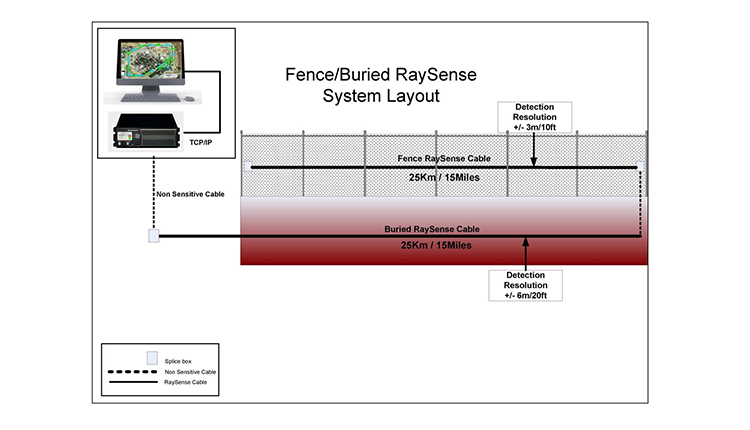Secure Your Residential Or Commercial Property With Reliable Fiber Optic Protection Solutions
In a period where protection dangers are increasingly sophisticated, the need for efficient security services is vital. Fiber optic safety and security systems stand out by providing exceptional integrity and performance, leveraging sophisticated light transmission innovation to boost surveillance capabilities. security fibers. Recognizing the complexities of fiber optic safety and security can brighten the path to safeguarding your building much more effectively.
Advantages of Fiber Optic Safety And Security
Fiber optic safety options use a variety of advantages that make them progressively necessary in today's digital landscape. Among the most substantial advantages is their premium data transfer ability, which enables for the transmission of big amounts of information over long distances without substantial signal deterioration. This ability is especially useful for protection systems that depend on high-def video surveillance and real-time tracking.
In addition, fiber optic cables are naturally much more secure than conventional copper wiring. They are immune to electro-magnetic interference, making them much less vulnerable to hacking or eavesdropping. This enhanced safety and security is vital for securing sensitive data and keeping the stability of monitoring systems.
Furthermore, optical fiber are a lot more sturdy and immune to ecological factors, such as dampness and temperature fluctuations, making certain long-term integrity and reduced maintenance prices. The lightweight nature of fiber optic cable televisions likewise streamlines installment processes, enabling greater versatility in system design.
Just How Fiber Optic Systems Work
In modern security applications, the procedure of fiber optic systems counts on the principles of light transmission through adaptable glass or plastic fibers. These fibers are developed to bring light signals over long ranges with marginal loss, making them optimal for transferring information associated with safety and security monitoring. The core of the fiber, surrounded by a cladding product, guarantees that light signals stay included within the core via a phenomenon understood as total internal reflection.
When incorporated right into security systems, fiber optic cables can transfer information from numerous sensors, such as video cameras, activity detectors, and alarm systems, to a central tracking terminal. The high data transfer capacity of optical fiber enables the transmission of large quantities of data at the same time, making it possible for real-time security and timely reaction to possible dangers.

Kinds Of Fiber Optic Security Solutions
Different kinds of fiber optic safety and security remedies have emerged to enhance monitoring and protection throughout different settings. One prominent remedy is fiber optic perimeter breach discovery systems (PIDS), created to monitor and secure residential or commercial property borders via the discovery of resonances and disturbances along fiber optic cords. These systems provide real-time alerts, enabling prompt feedbacks to unauthorized gain access to efforts.
One more effective solution is fiber optic video clip monitoring. This technology leverages high-definition cams attached using fiber optic cables to send video clip data over cross countries without substantial loss of top quality. This arrangement is specifically valuable in extensive locations, such as flight terminals and industrial sites, where standard copper cords may falter.
Additionally, fiber optic sensors are increasingly used for ecological monitoring, discovering changes in temperature, pressure, or acoustic signals that could indicate safety breaches or harmful problems. These sensing units provide high sensitivity and precision, making them perfect for essential infrastructure security.

Setup and Maintenance Tips
Effective installation and maintenance of fiber optic safety services are important for ensuring their optimum performance and longevity. To begin with, it is important to prepare the installment very carefully, considering the layout of the residential property and determining prospective vulnerabilities. Fiber optic cords need to be directed safely, preventing sharp bends or spins that could jeopardize their honesty. Make use of professional-grade adapters and rooms to make certain robust links and protection from ecological aspects.
Throughout installment, it is suggested to conduct comprehensive testing of the system to confirm that all parts are functioning properly. Routine maintenance checks need to be set up to check the fiber optic cable televisions for any kind of indicators of wear or damage, as well as to ensure that connections continue to be safe. Cleaning up the ports periodically this link is likewise crucial to avoid signal loss due to dust or debris.
Furthermore, maintaining an updated supply of installed parts and their specifications can facilitate easier troubleshooting and upgrades. By sticking to these setup and maintenance pointers, home owners can make the most of the efficiency of their fiber optic protection solutions, making certain a trustworthy protection against prospective dangers.
Comparing Costs and Performance
When assessing fiber optic security remedies, comprehending the balance between prices and effectiveness comes to be paramount (security fibers). Organizations should think about the in advance investment, ongoing maintenance costs, and the long-lasting worth these systems provide. While fiber optic systems may require a greater initial installment expense compared to standard copper electrical wiring, their resilience and decreased vulnerability to electro-magnetic disturbance commonly equate to reduced upkeep costs in time
Efficiency is an additional essential aspect; fiber optic security systems use boosted information transmission speeds and improved integrity. They can cover larger distances without signal degradation, making them perfect for large properties or remote areas. Moreover, the high bandwidth capability supports sophisticated protection applications, such as high-definition video clip security and real-time Resources surveillance, which are important for extensive security management.
Inevitably, the choice between expense and performance ought to be directed by specific safety requirements and run the risk of assessments. Organizations needs to examine their one-of-a-kind demands, thinking about factors like property size, safety and security risks, and technical developments. By performing a thorough cost-benefit analysis, stakeholders can make educated choices that align with their protection goals while making sure a sound investment in fiber optic innovation.
Verdict
In verdict, fiber optic protection options provide significant benefits in terms of performance, reliability, and resistance to ecological interferences. Eventually, the fostering of fiber optic technology represents a forward-thinking technique to protecting residential properties versus developing safety hazards.